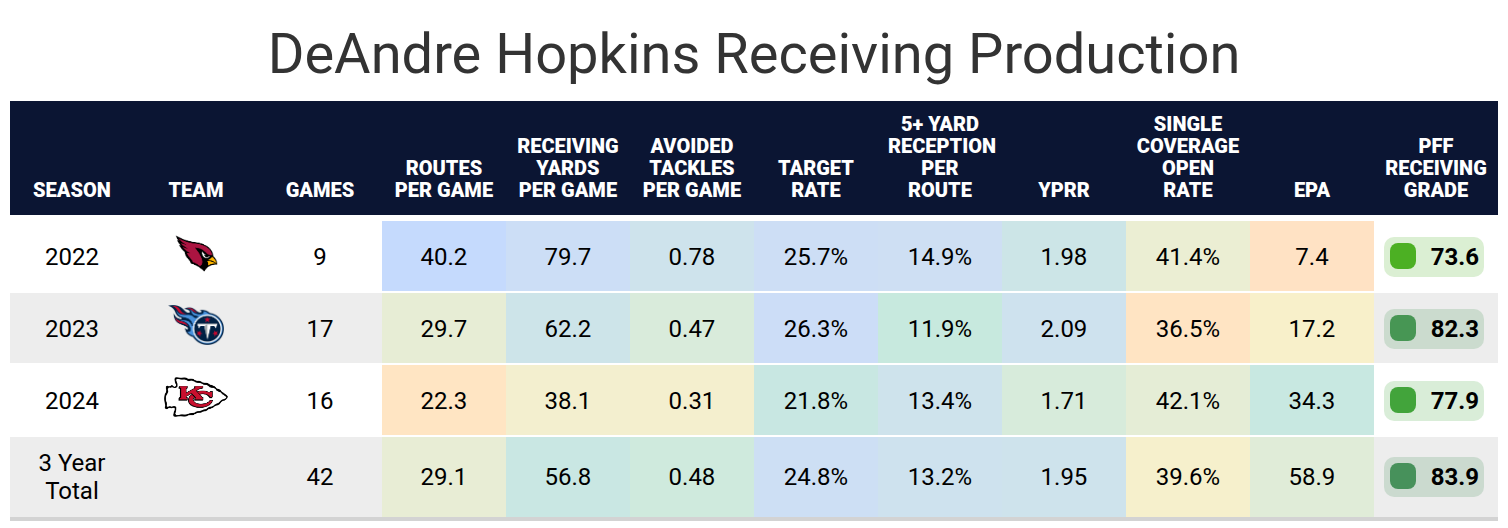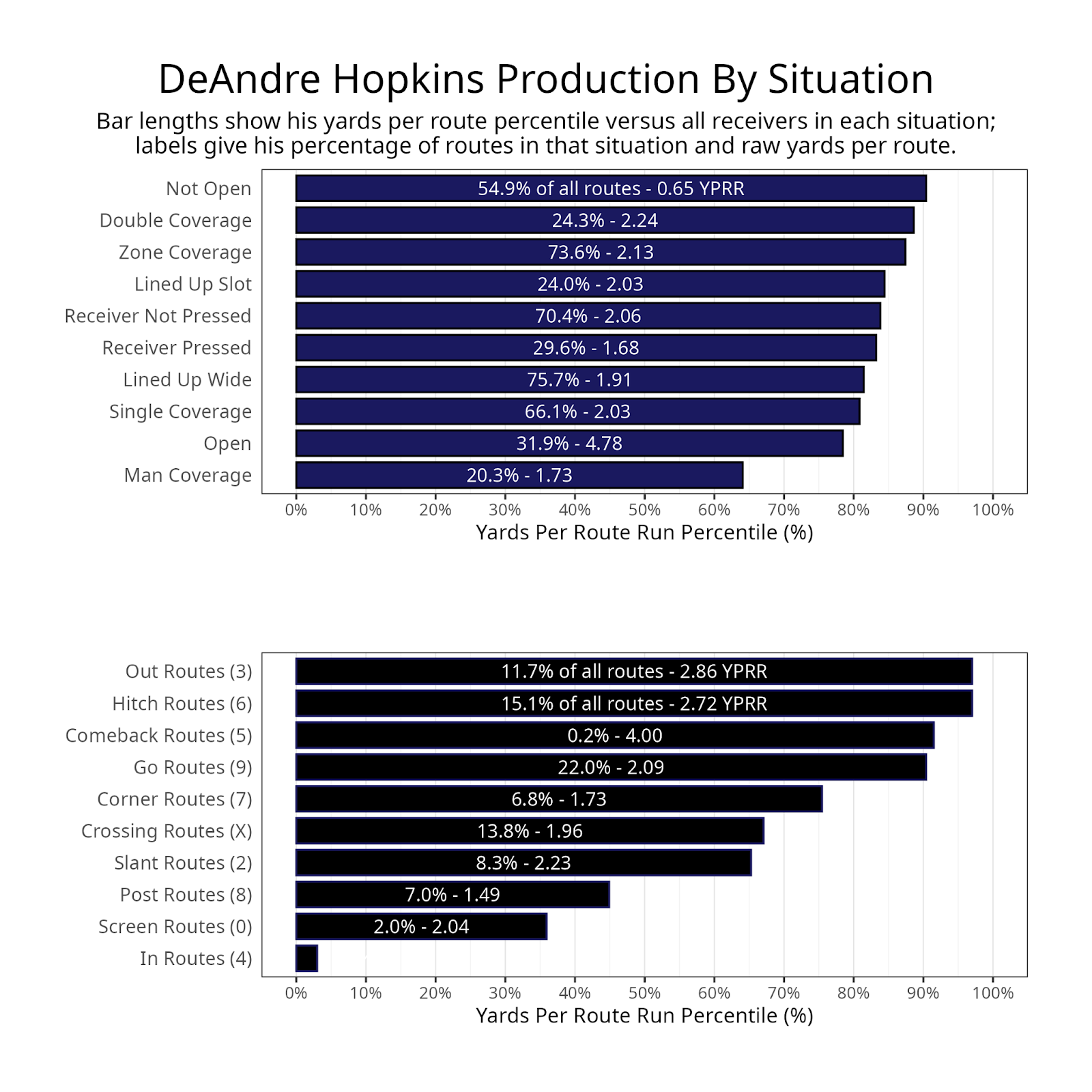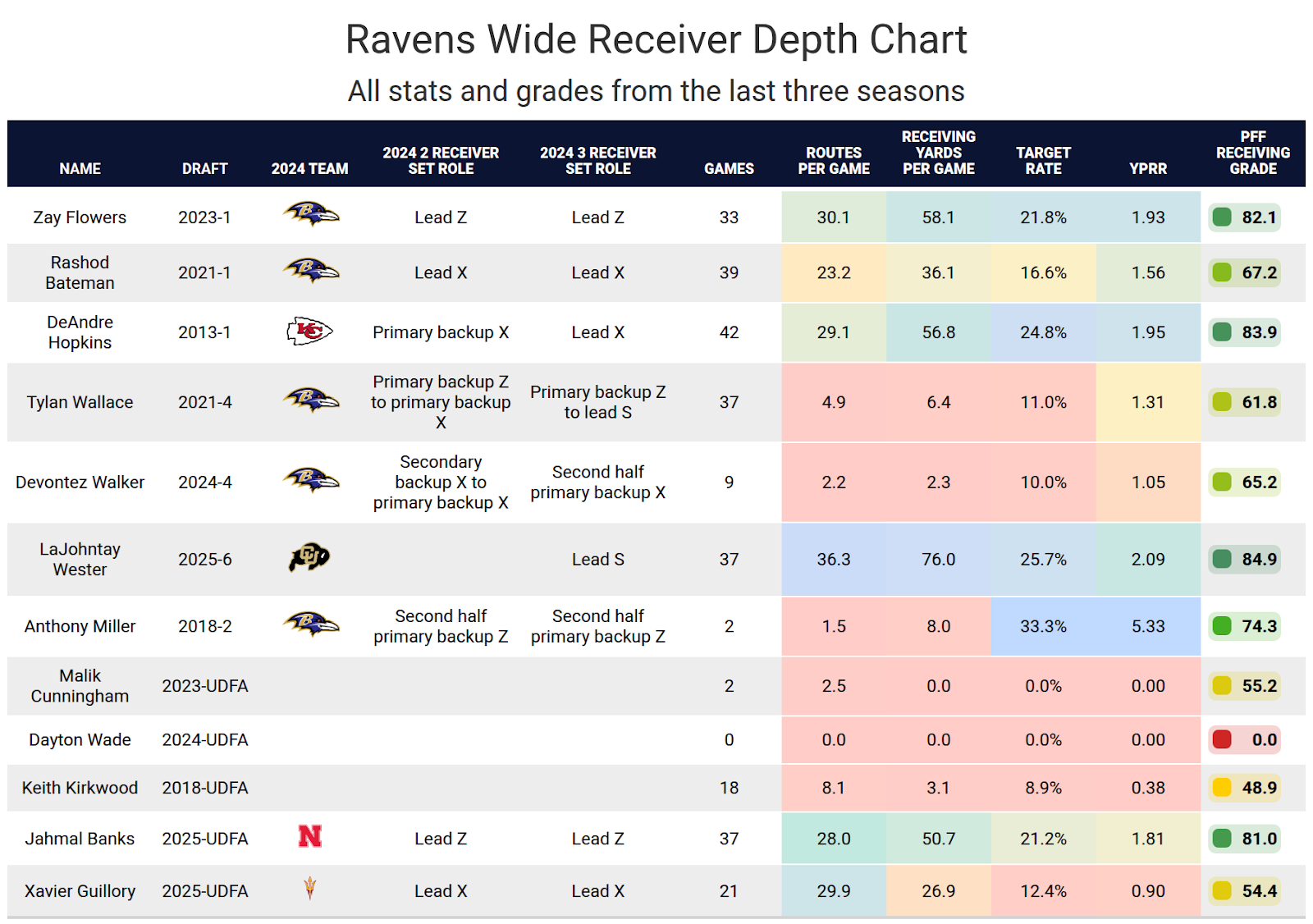
- An all-time great receiver: DeAndre Hopkins was a top-five fantasy wide receiver in five of six seasons from 2015 to 2020, showing his dominance in his prime years.
- Baltimore Ravens crowded receiver room: Hopkins faces a battle for targets and playing time in a crowded offensive lineup, making it unlikely he makes much of an impact for fantasy leagues.
- Subscribe to PFF+: Get access to player grades, PFF Premium Stats, fantasy football rankings, all of the PFF fantasy draft research tools and more!
Estimated Reading Time: 5 minutes

PFF’s Fantasy Football Player Profile series delivers the most in-depth fantasy football analysis available for the 2025 season.
Using PFF’s exclusive data, we evaluate player performance, competition for touches and how teammates and coaching staffs
Last updated: 7:15 a.m. Tuesday, June 24
Player performance
DeAndre Hopkins is a future Hall of Fame wide receiver who spent the first seven years of his career with the Houston Texans, followed by three years with the Arizona Cardinals. From 2015 to 2020, Hopkins was a top-five fantasy wide receiver in five of six seasons. He similarly had an 88.0-plus PFF receiving grade in five of those six seasons.
Hopkins remarkably missed only one game in his first eight seasons, but injuries began to impact him in 2021, primarily with hamstring issues, followed by an MCL tear at the end of the year. This caused him to miss the first six weeks of 2022, and a knee injury ended his season two weeks early. His PFF receiving grade started to decline, but he was still a top-24 wide receiver in points per game.
He joined the Tennessee Titans in 2023. While he didn’t miss a game, Hopkins was rotated out more often than in past seasons. He averaged 72% of Tennessee‘s offensive snaps on the season, and a lot of the plays he missed were pass plays. Therefore, his routes per game took a notable dip. He still played well, finishing with a high target rate and yards per route run.
At 32 years old, the Titans cut back on Hopkins’ playing time even further in 2024. He played less than 50% of the team’s offensive snaps each of the first four weeks due to an MCL tear in training camp. He played more in Weeks 6 and 7, but the Titans opted to trade Hopkins to the Kansas City Chiefs. He caught eight passes for 86 yards and two touchdowns in an overtime win against the Tampa Bay Buccaneers. His playing time peaked with the Kansas City Chiefs the following week at 65%.
Hopkins only exceeded 50% of his team’s offensive snaps twice over the rest of the season. He gained 90 yards in Week 13, but he was held under 40 yards in six of his last seven regular-season games. In the playoffs, his role was restricted even further, while his former Cardinals teammate Hollywood Brown saw his role increase. Hopkins played less than 40% of the snaps in all three playoff games and caught a combined three passes for 29 yards.
This all led Hopkins to have 9.2 fantasy points per game in 2024, the 60th-best among wide receivers. Despite his recent downturn in play, his 0.44 fantasy points per route over the past five seasons have been 11th-best among wide receivers.


Projected role
Hopkins signed a one-year, $5 million contract with the Baltimore Ravens this offseason. That is half as much money as players like Tutu Atwell and Dyami Brown were signed for this spring. This was a clear sign Hopkins is trying to end his career with a Super Bowl win. He lost the Super Bowl last season, and the Ravens are one of the top Super Bowl favorites.
Hopkins joins a Ravens team that already has an X receiver, Rashod Bateman. The Ravens run a lot of two-receiver sets, so Bateman and Hopkins will likely be in some kind of rotation. In three-receiver sets, we will ideally see both Bateman and Hopkins on the outside, while Zay Flowers is in the slot. The Ravens similarly have too much talent at tight end with Mark Andrews and Isaiah Likely. Four of these five players should be on the field for most pass plays.
This likely means Hopkins’ routes per game will be similar to last season, if not worse. That won’t be enough to make Hopkins fantasy-relevant this season, outside of DFS and best ball. However, Hopkins’ receiving grades have remained high, even if they aren’t Hopkins at his peak, but they are high relative to other receivers. There is a chance Hopkins can take the starting role from Bateman and become a favorite target of Lamar Jackson. Based on Hopkins’ talent at 33 years old, a WR3 season is a possibility, but only if Bateman is out of his way.


Impact of teammates
Hopkins joins the Baltimore Ravens and Todd Monken’s offense. This isn’t the first time Monken has experience with a new 33-year-old receiver. In 2009, he was the wide receivers coach for the Jacksonville Jaguars, and Torry Holt signed with the team for his only season away from the St. Louis Rams. He caught 51 passes for 722 yards but was only 61st in fantasy points per game.
Monken’s offense has been run-heavy, largely thanks to the Derrick Henry addition last season. The very low rate of running three-receiver sets is a big reason it will be difficult for Hopkins and Rashod Bateman to co-exist.
The good news is he’s going to play with Lamar Jackson, who has had a very high passing grade in recent seasons. While Hopkins played with fine quarterbacks in his career, going from one future Hall of Famer to another certainly helps his case of potentially having value at this stage of his career.


Bottom line
DeAndre Hopkins was once an excellent fantasy receiver, but his value has rapidly declined as one of the league’s oldest receivers. While his days of being a fantasy starter are likely over with a very crowded offense, he’s still a talented wide receiver catching passes from a talented quarterback, so there’s a chance his value rebounds.

Footnotes
- Statistics in tables and charts were chosen based on their ability to predict future fantasy performance on a per-game or per-opportunity basis or to describe the player relative to others at the same position.
- “Opportunities” are defined as passing dropbacks, rushing attempts and routes run as a receiver.
- Numbers are provided either by season or based on the past three years. For rookies, only college statistics are included. For non-rookies, only NFL statistics are considered, regardless of whether they played in college within the previous three years.
- As college competition is easier than NFL competition, most rookies are likely to see a decline from their historical numbers.
- Only FBS data is considered for college players and comparisons.
- Kneel-downs are removed from rushing data to provide cleaner quarterback rushing rate statistics.
- The table colors in this article range from blue (indicating good/high) to red (indicating bad/low).
- All percentiles and color codings compare the given player to others with a high sample of opportunities. Generally, the cutoff is one-third of the possible opportunities in the sample. If a player does not meet the threshold, they are still included in the comparison, though their results may appear better or worse than expected due to the smaller, less predictive sample size.
- Information on utilization classifications and their importance can be found here for running backs, wide receivers and tight ends.
This news was originally published on this post .






Be the first to leave a comment